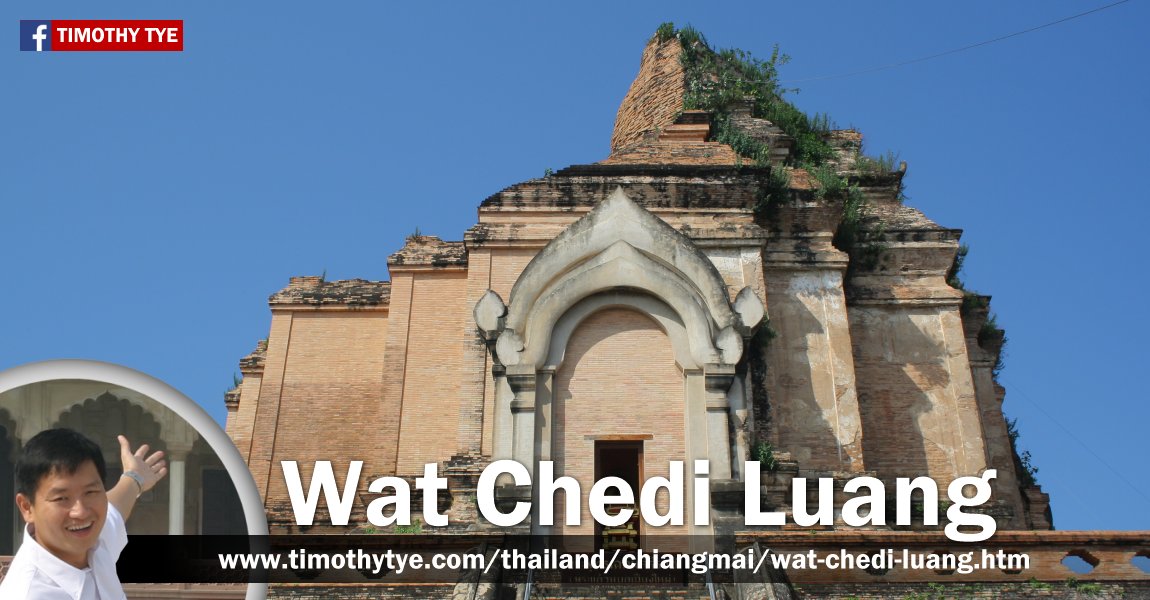 Front façade of the Great Stupa. (24 October, 2006)
Front façade of the Great Stupa. (24 October, 2006)
Wat Chedi Luang (GPS: 18.78696, 98.98658; Thai: วัดเจดีย์หลวง
 ) is the biggest temple in Chiang Mai, Thailand. It is also known by its official name Wat Chedi Luang Waraviharn, and by its old name Wat Jotikaram. Wat Chedi Luang is located along Phra Pok Klao Road, at the heart of the old city of Chiang Mai. The main and most prominent feature of Wat Chedi Luang is its monumental chedi, which despite having been toppled by a massive earthquake in 1545, still towers over everything else in the immediate vicinity. Wat Chedi Luang is also the site of the City Pillar of Chiang Mai.
) is the biggest temple in Chiang Mai, Thailand. It is also known by its official name Wat Chedi Luang Waraviharn, and by its old name Wat Jotikaram. Wat Chedi Luang is located along Phra Pok Klao Road, at the heart of the old city of Chiang Mai. The main and most prominent feature of Wat Chedi Luang is its monumental chedi, which despite having been toppled by a massive earthquake in 1545, still towers over everything else in the immediate vicinity. Wat Chedi Luang is also the site of the City Pillar of Chiang Mai.The name Wat Chedi Luang means "Monastery of the Great Stupa". It encompasses not only the original Wat Chedi Luang, but two other monasteries Wat Ho Tham and Wat Sukmin, which all are consolidated within one expansive compound. The monastery dates back to the 14th century, when the ruler King Saen Muang Ma (1386-1401) built a reliquary to enshrine the ashes of his father, Ku Na. First he had the area cleared. Then a bodhi tree made with silver trunk and gold leaves was planted there. Next, he added a statue of Buddha in gold and another in silver. Then the base of the reliquary was built around them. At that time, it was called ku luang, or silver shrine, rather than chedi, as it did not contain any relics of the Buddha.
The work had only reached "eaves height" when King Saen Muang Ma died, and his wife took over supervision of the project. The construction was plagued with more than its share of problems. At one point part of it collapsed. Still, construction continued on and off, until the mid 15th century, when it was finally completed, during the reign of King Tilokaraj (1442-1487), the 9th ruler of the Mangrai Dynasty, who strengthen it with laterite. The completed structure was the tallest in medieval Chiang Mai, standing 82 meters (270 ft) tall and had a base which was 54 meter wide.
In 1468, the famous Emerald Buddha, Phra Kaeo Morakot, which today is housed in the Temple of the Emerald Buddha in Bangkok, was installed here. On the four sides of the chedi are gigantic staircases flanked by naga balustrades. Surrounding the base are Sinhalese-style elephants, similar perhaps to those at Ruwanweliseya in Anuradhapura.
In 1545, during the reign of Queen Chiraprabha (1545-1546), 15th ruler of the Mangrai Dynasty, a massive rainstorm coupled with an earthquake brought down the top 30 meters of the chedi. In 1551, King Setthathirat of Laos, who was ruling Chiang Mai at that time, he took with him the Emerald Buddha when he returned to Luang Prabang. Recently, to commemorate the 600th anniversary of the chedi, a replica of the Emerald Buddha made of very dark jade, called Phra Yok (jade buddha) was installed in the eastern niche.
As you enter the compound of Wat Chedi Luang from the main entrance to the east, you come upon a modern viharn which was built in 1928, and renovated in 1999. It contains a large standing Buddha image, called Phra Chao Attarot (eighteen-cubit Buddha), which was cast in the 14th century. On your left is the city pillar.
 Entrance to Wat Chedi Luang, Chiang Mai (24 October, 2006)
Entrance to Wat Chedi Luang, Chiang Mai (24 October, 2006)
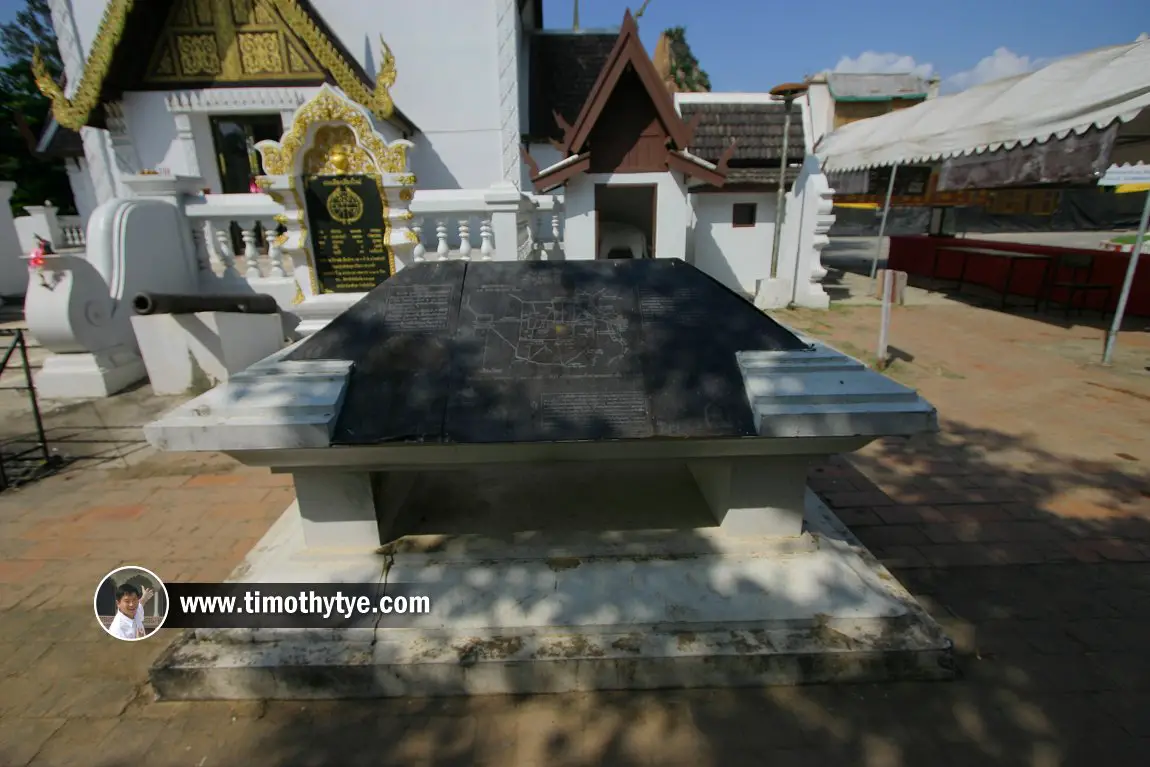 Floor plan of Wat Chedi Luang on granite slab. (24 October, 2006)
Floor plan of Wat Chedi Luang on granite slab. (24 October, 2006)
 The bell tower of Wat Chedi Luang. (24 October, 2006)
The bell tower of Wat Chedi Luang. (24 October, 2006)
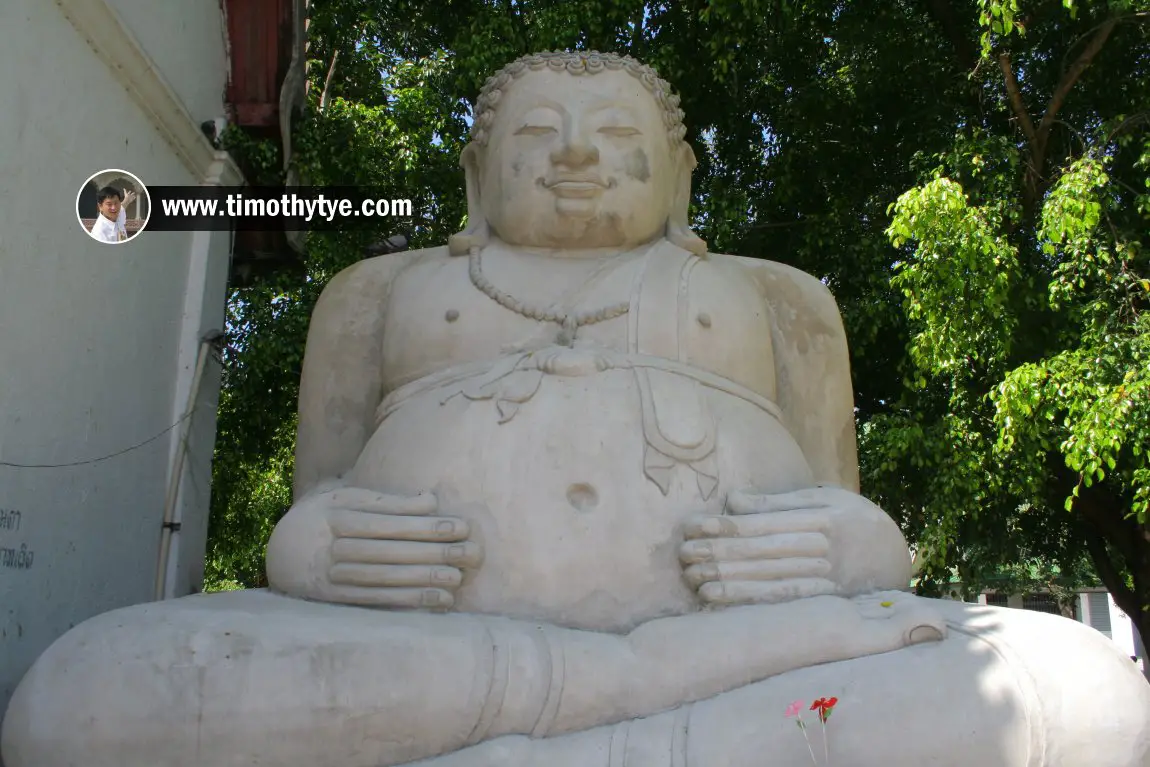 A rotund figure within the grounds of Wat Chedi Luang. (24 October, 2006)
A rotund figure within the grounds of Wat Chedi Luang. (24 October, 2006)
 Shrine to an elephant statue at Wat Chedi Luang. (24 October, 2006)
Shrine to an elephant statue at Wat Chedi Luang. (24 October, 2006)
 The Great Stupa of Wat Chedi Luang. (24 October, 2006)
The Great Stupa of Wat Chedi Luang. (24 October, 2006)
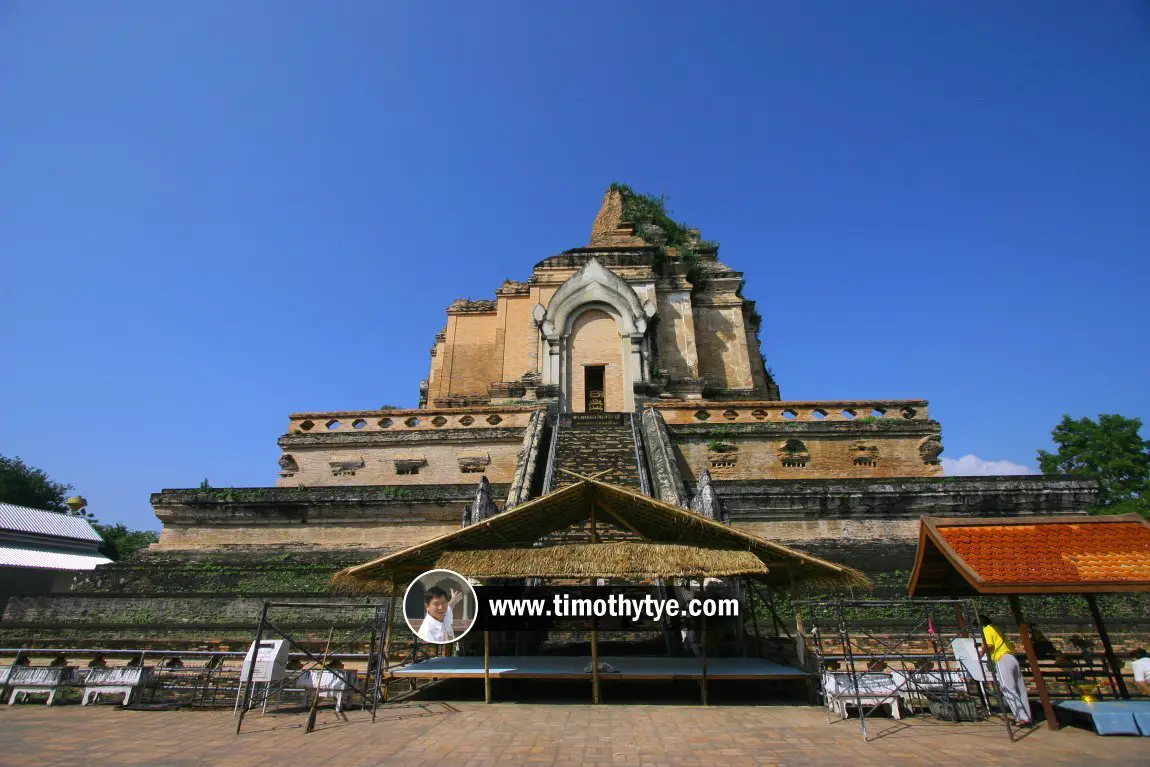 The Great Stupa of Wat Chedi Luang. (24 October, 2006)
The Great Stupa of Wat Chedi Luang. (24 October, 2006)
 The Great Stupa, as seen from one of its sides. (24 October, 2006)
The Great Stupa, as seen from one of its sides. (24 October, 2006)
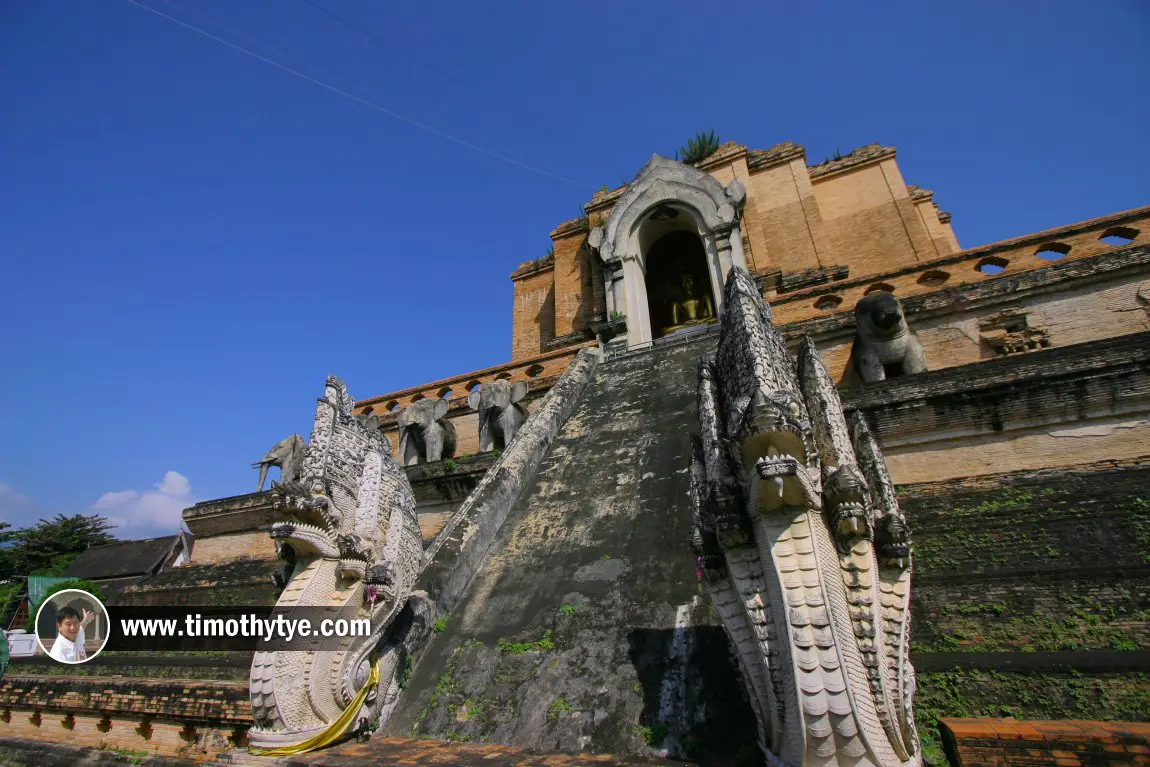 Naga balustrades on the side of the Great Stupa. (24 October, 2006)
Naga balustrades on the side of the Great Stupa. (24 October, 2006)
Wat Chedi Luang on Google Street View
Entrance to Wat Chedi Luang (May 2017)City Pillar Shrine of Chiang Mai
City Pillar of Chiang Mai is located within the grounds of Wat Chedi Luang, in the heart of the Old City. The city pillar, or lak muang, is called Sao Inthakin (Indra's pillar). It is made of brick, and is 50 centimeters tall, and housed within an octagonal brick structure.The City Pillar of Chiang Mai was originally located at Wat Sadeu Muang. It was moved here by Chao Kawila in the year 1800, when Chiang Mai was being rebuilt and repopulated. At the same time, three dipterocarp trees, called Yang Tree, were planted at the grounds. The largest of them all tower above the City Pillar Shrine. Local belief is that the tree helps to protect the city for as long as it stands.
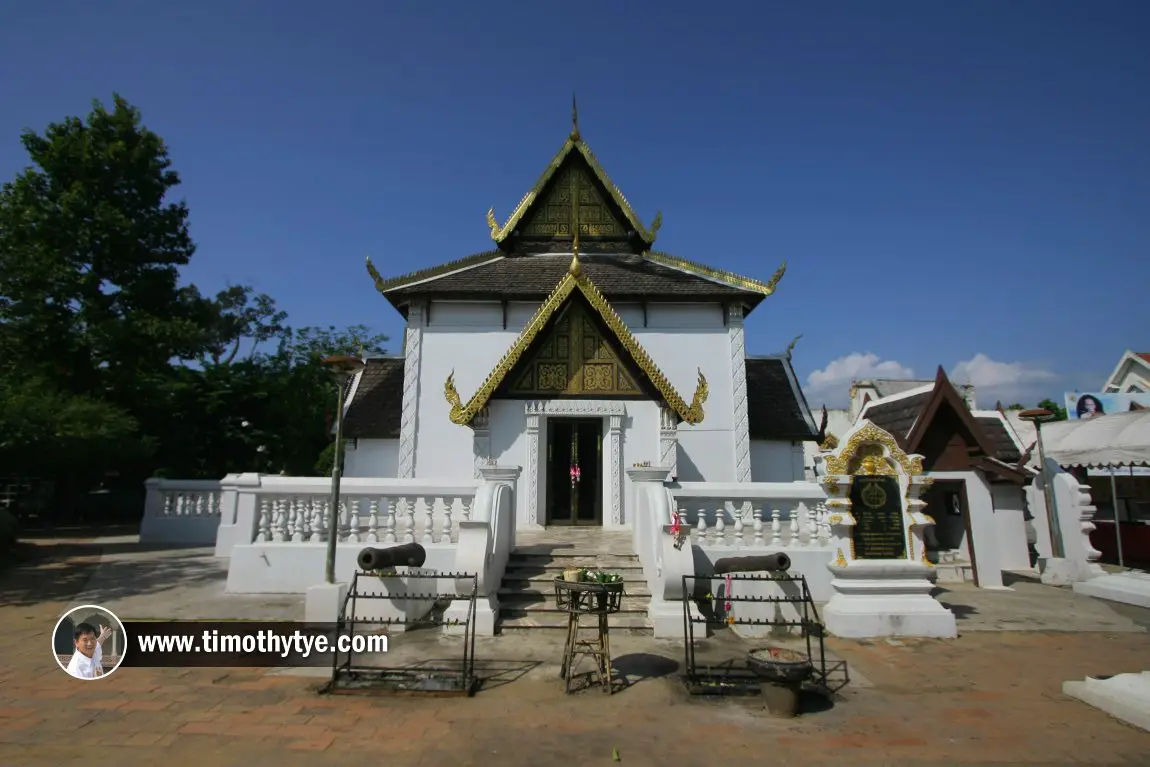 Lak Muang, or City Pillar Shrine, of Chiang Mai (24 October, 2006)
Lak Muang, or City Pillar Shrine, of Chiang Mai (24 October, 2006)
 Lak Muang, or City Pillar Shrine, of Chiang Mai (24 October, 2006)
Lak Muang, or City Pillar Shrine, of Chiang Mai (24 October, 2006)
 City Pillar Shrine of Chiang Mai (24 October, 2006)
City Pillar Shrine of Chiang Mai (24 October, 2006)
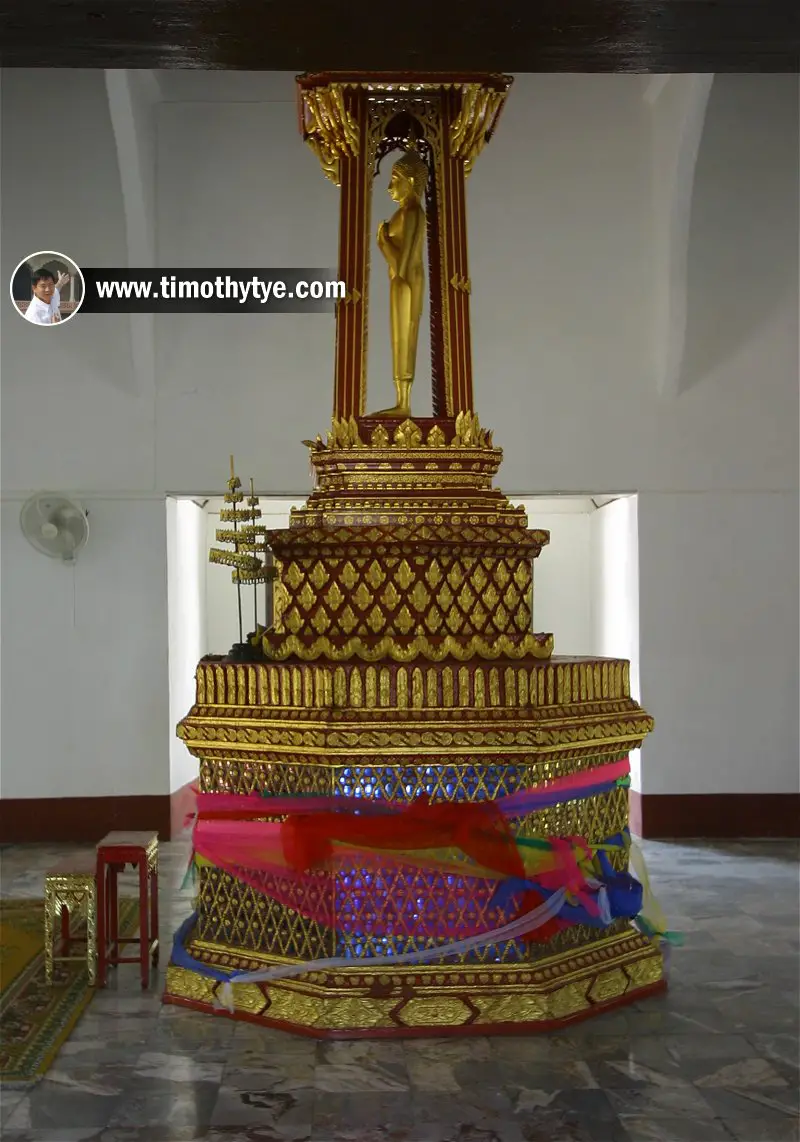 City Pillar of Chiang Mai (24 October, 2006)
City Pillar of Chiang Mai (24 October, 2006)
Mahamakut Buddhist University, Lanna Campus
The Lanna Campus of Mahamakut Buddhist University, is located within the grounds of Wat Chedi Luang. As you enter Wat Chedi Luang from the main entrance, the campus is located on your right.The Mahamakut Buddhist University was founded by King Chulalongkorn (Rama V) in 1893 as the Mahamakut Royal Academy. In 1945, it was inaugurated as the first Buddhist University in Thailand, and catered for Buddhist monks and novices. While its main campus is in Bangkok, the university has its Chiang Mai campus within the grounds of Wat Chedi Luang. It is the northern campus of the monks of the Thammayut sect, a sect founded by King Mongkut (Rama IV).
 Mahamakut Buddhist University, Lanna Campus
Mahamakut Buddhist University, Lanna Campus (24 October 2006)

Northern Stupa
The Northern Stupa of Wat Chedi Luang is said to be very old, although the exact date of its construction is unknown. It is a square-shape stupa with a three-dentate body and two-dentate lotus-shape base.The middle part of the Northern Stupa is covered with gilded metal plates while its pinnacle and parasol are made of brass and also gilded. The northern stupa of Wat Chedi Luang is 13.43 meters tall and measures 6.55 meters wide at the base. It was restored in 1993.
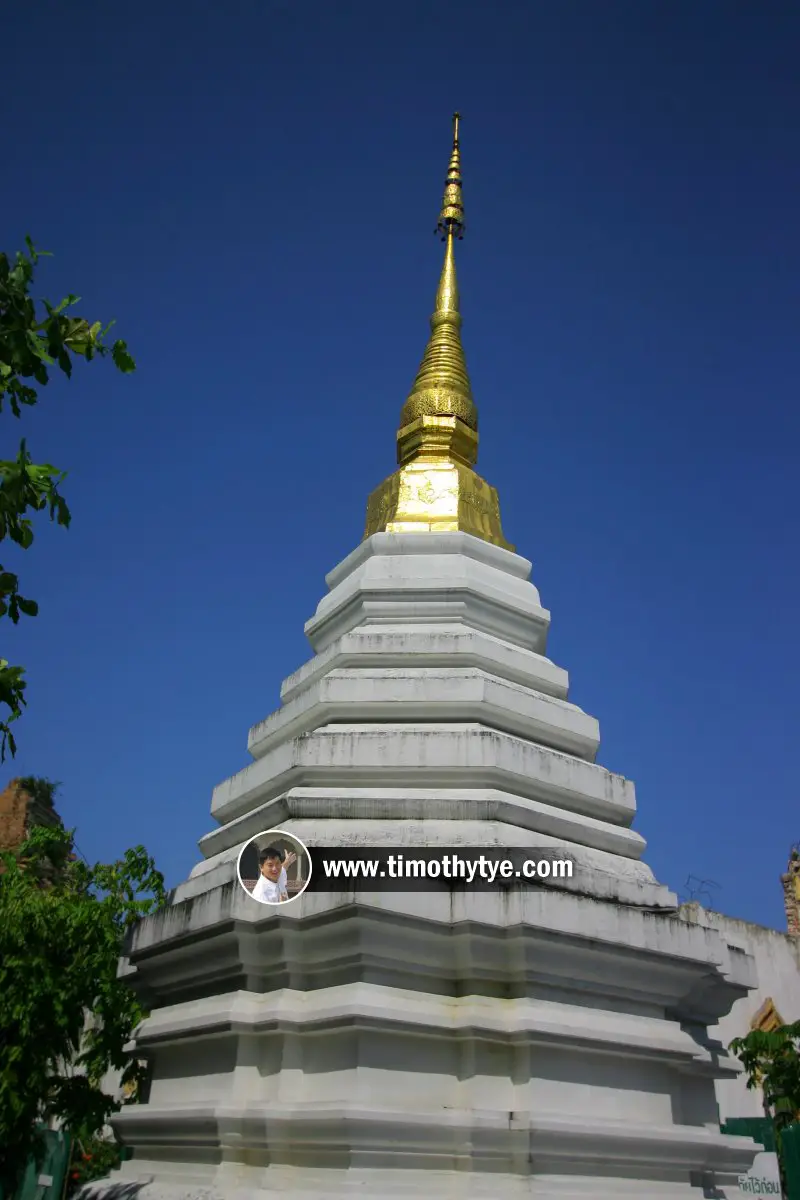 The Northern Stupa of Wat Chedi Luang. (24 October, 2006)
The Northern Stupa of Wat Chedi Luang. (24 October, 2006)
 Another view of the Northern Stupa. (24 October, 2006)
Another view of the Northern Stupa. (24 October, 2006)
Phaya Yakkharaj (Southern Pavilion)
Phaya Yakkharaj is a pavilion within the grounds of Wat Chedi Luang. It was built by Chao Kawila in 1800 as the shrine to two guardian spirits, or Yaksha. The guardian spirits are to protect the City Pillar of Chiang Mai.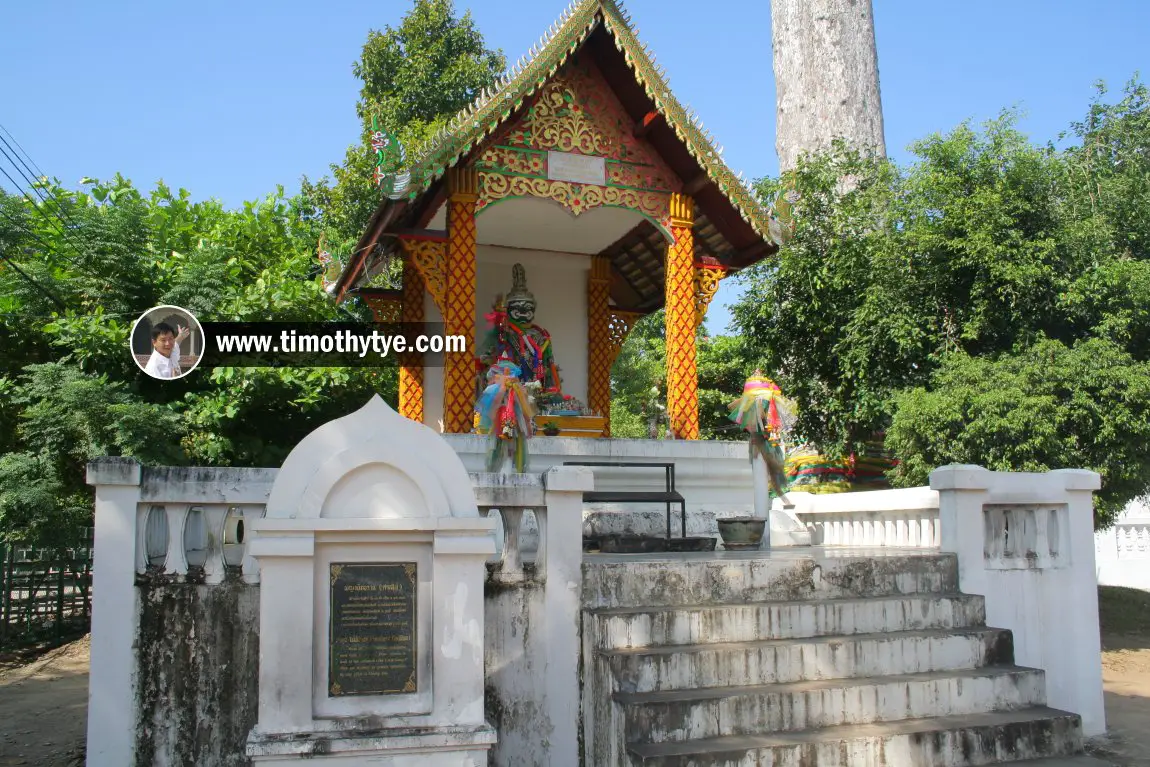 Phaya Yakkharaj, or Southern Pavilion, of Wat Chedi Luang (24 October, 2006)
Phaya Yakkharaj, or Southern Pavilion, of Wat Chedi Luang (24 October, 2006)
Ubosot of Wat Chedi Luang
The Old Ordination Hall, or Ubosot, of Wat Chedi Luang is located behind the main chedi. It measures 20.33 meters long and 8.95 meters wide. It was built in 1883 in the Lanna architectural style and was renovated in 1948. It was last restored in 1997 through the patronage of one Mrs Boothong Kitibut. However, it has not been used since 1985 when some part of the Grand Vihara of Wat Chedi Luang was turned into an ordination hall in 1979. The Ubosot, or Ordination Hall, of Wat Chedi Luang (24 October, 2006)
The Ubosot, or Ordination Hall, of Wat Chedi Luang (24 October, 2006)
Acharn Mun Bhuridatto Viharn
Acharn Mun Bhuridatto Viharn is named after a venerated monk of the 19th century. It is located within the grounds of Wat Chedi Luang. Acharn Mun Bhuridatto was born in 1870 and became a renowned meditation master in Thailand.The Acharn Mun Bhuridatto Viharn is located to the west of the chedi of Wat Chedi Luang. It is highly ornate, with ornamentation covering every panel of the pediment. A short flight of stairs leads up into the viharn, flanked on either sides by naga balustrades. Within the viharn is a reliquary.
Next to Acharn Mun Bhuridatto Viharn is another pavilion. Unfortunately I am unable to get its name, as the signboard was posted only in Thai.
 Acharn Mun Bhuridatto Viharn at Wat Chedi Luang (24 October, 2006)
Acharn Mun Bhuridatto Viharn at Wat Chedi Luang (24 October, 2006)
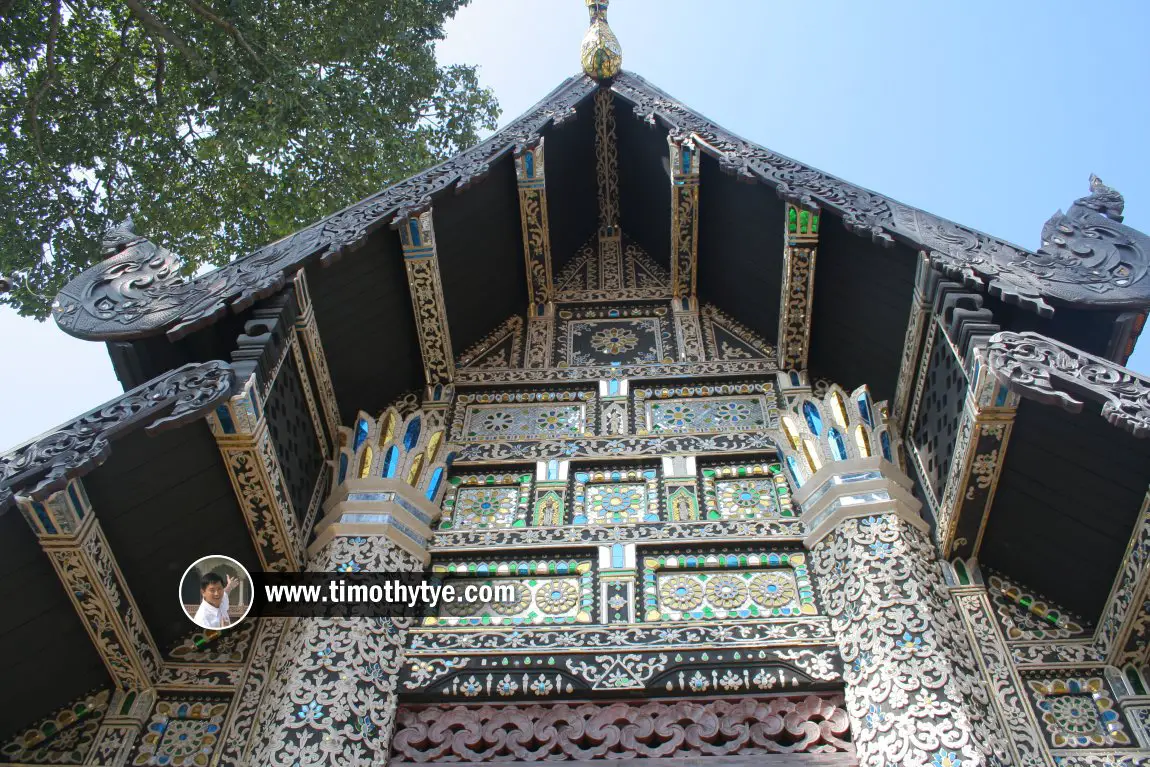 Acharn Mun Bhuridatto Viharn at Wat Chedi Luang (24 October, 2006)
Acharn Mun Bhuridatto Viharn at Wat Chedi Luang (24 October, 2006)
 Interior of Acharn Mun Bhuridatto Viharn. (24 October, 2006)
Interior of Acharn Mun Bhuridatto Viharn. (24 October, 2006)
 Interior of Acharn Mun Bhuridatto Viharn at Wat Chedi Luang (24 October, 2006)
Interior of Acharn Mun Bhuridatto Viharn at Wat Chedi Luang (24 October, 2006)
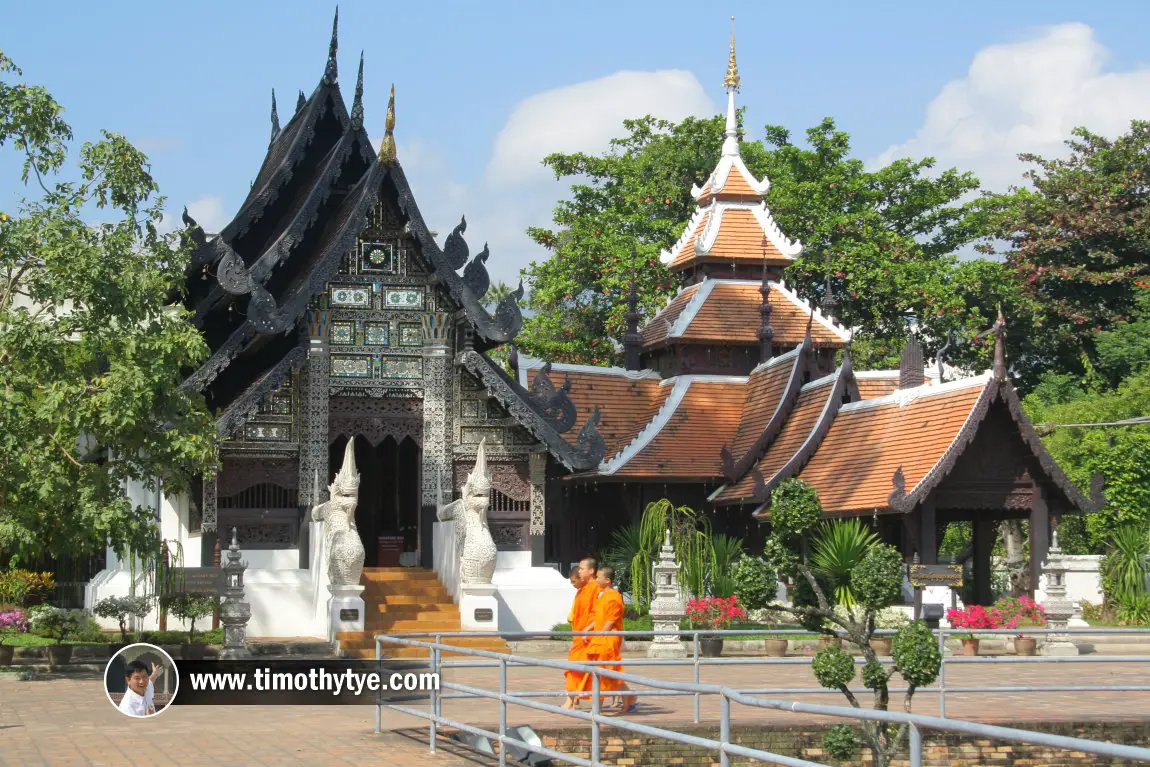 Buildings within the grounds of Wat Chedi Luang. (24 October, 2006)
Buildings within the grounds of Wat Chedi Luang. (24 October, 2006)
 Beautiful wooden pavilion at Wat Chedi Luang (24 October, 2006)
Beautiful wooden pavilion at Wat Chedi Luang (24 October, 2006)
The Reclining Buddha of Wat Chedi Luang
Called Pha Buddhasaiyat, the Reclining Buddha of Wat Chedi Luang is believed to have been built during the reign of Phra Muang Kaeo, the 11th monarch of the Mang Rai Dynasty (1487-1517). Measuring 1.93 meters high and 8.70 meters long, the Buddha is aligned to face the Great Stupa. A pavilion was erected in 1955 to enshrine it when the Venerable Phra Buddhisophon was abbot.The Buddha in the reclining posture is always depicted on his right side. He is said to do so only one hour each night for the entire 45 years of his teaching.
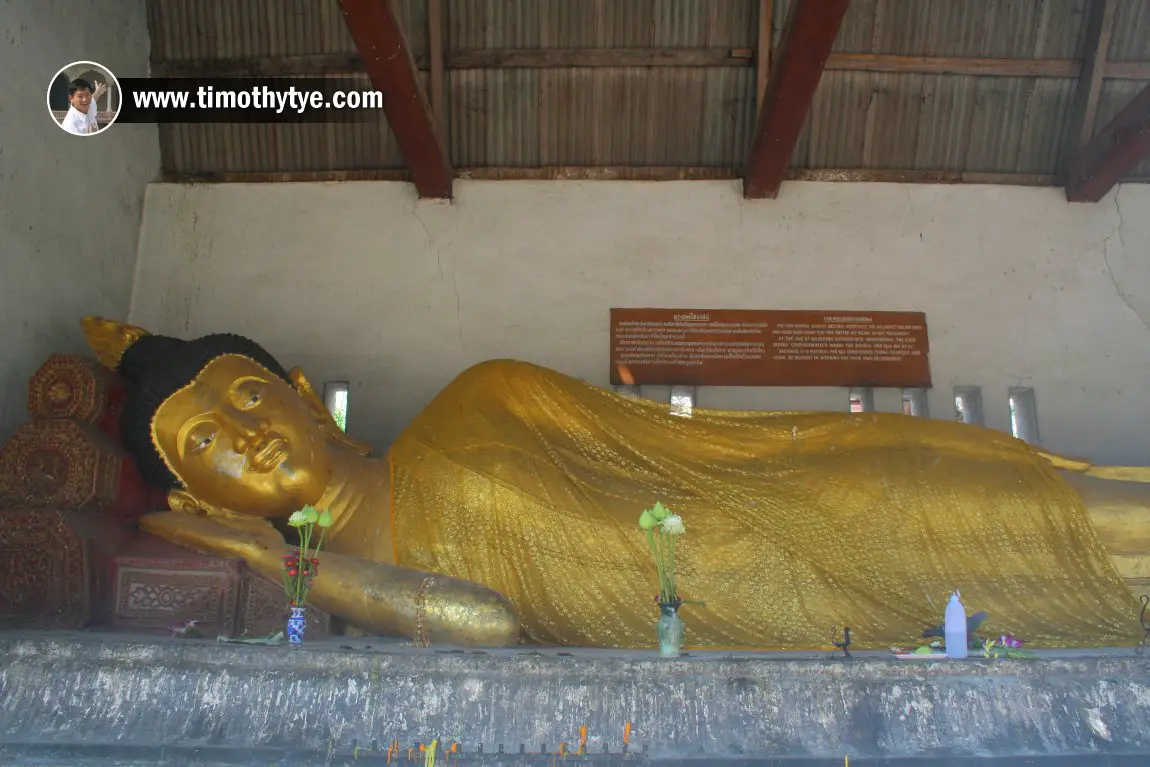 The Reclining Buddha of Wat Chedi Luang (24 October, 2006)
The Reclining Buddha of Wat Chedi Luang (24 October, 2006)
The Yang Na Tree of Wat Chedi Luang
The Yang Na Tree is a dipterocrap tree within the ground of Wat Chedi Luang. It was planted by Chao Kawila when he established Chiang Mai in 1796. The tree planting marked the establishment of the city of Chiang Mai. Today the Yang Tree towers over the City Pillar Shrine, which houses the City Pillar. The City Pillar was moved to the spot under the Yang Tree from Wat Sadue Muang.Updates
8 January, 2018Chiang Mai City Life reported that the Minister of Culture, Veera Rojpojanarat, attended a blessing ceremony which aims to protect the historical Yang Na Tree of Wat Chedi Luang. It is one of the four sites in Chiang Mai, out of a total of 65 sites throughout Thailand where the trees are to be given special protection. Details
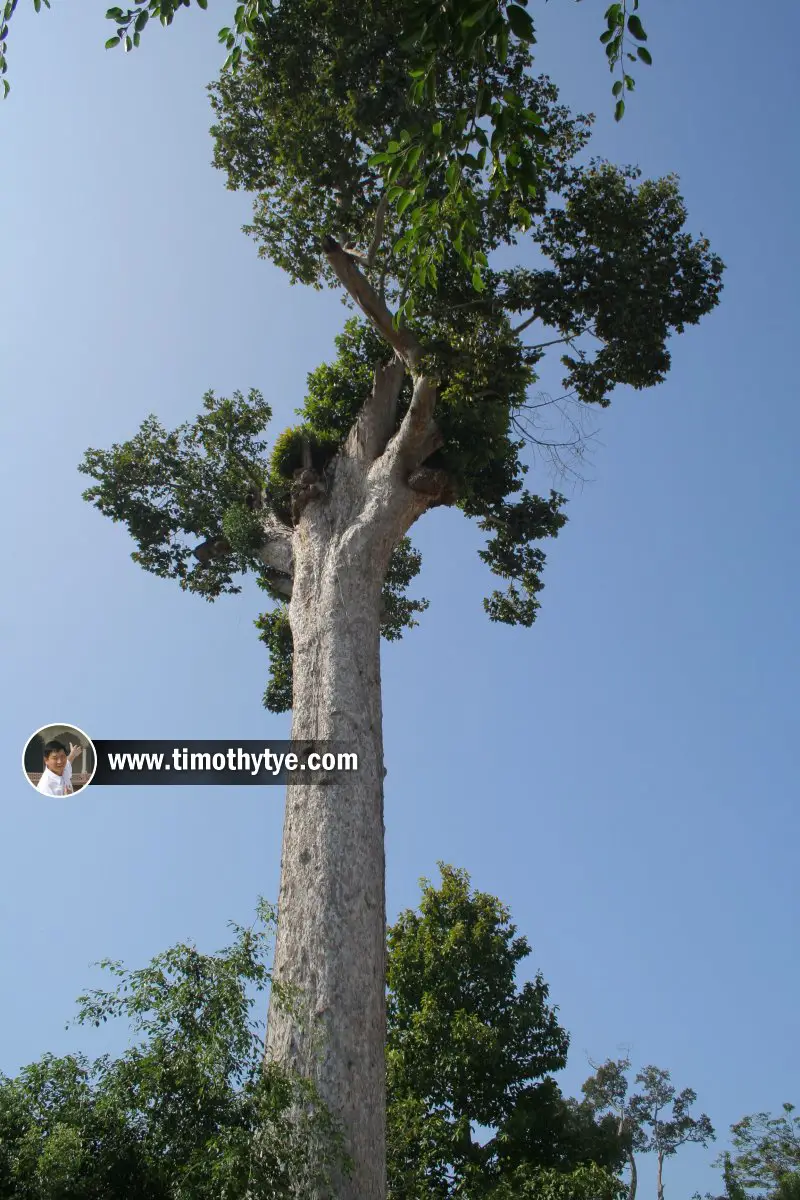 The Yang Na Tree at Wat Chedi Luang (24 October, 2006)
The Yang Na Tree at Wat Chedi Luang (24 October, 2006)
Getting there
Wat Chedi Luang is located in the middle of Chiang Mai, on the south side of Ratchadamnoen Road, at the junction with Phra Pok Klao Road. It is across the road from the Lanna Architecture Center. The entrance faces Phra Pok Klao Road.Wat Chedi Luang is  on the map of Chiang Mai
on the map of Chiang Mai
List of Wats in Chiang Mai and Wats in Thailand
[an error occurred while processing this directive] Latest updates on Penang Travel Tips
Latest updates on Penang Travel Tips
 Map of Roads in Penang
Map of Roads in Penang
Looking for information on Penang? Use this Map of Roads in Penang to zoom in on information about Penang, brought to you road by road.Disclaimer
Please use the information on this page as guidance only. The author endeavours to update the information on this page from time to time, but regrets any inaccuracies if there be any.
Copyright © 2003-2025 Timothy Tye. All Rights Reserved.

 Go Back
Go Back